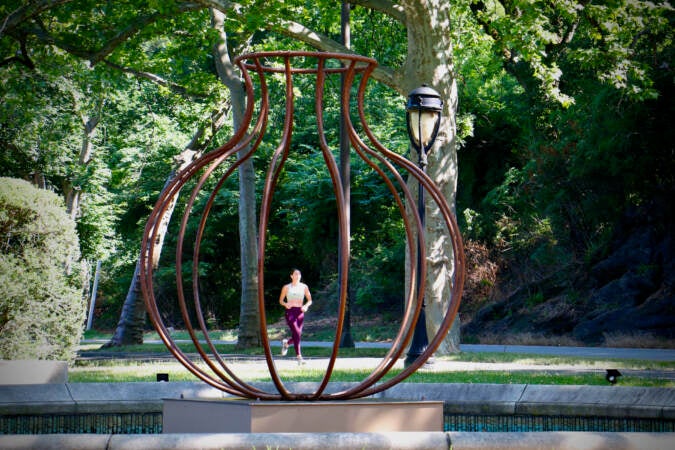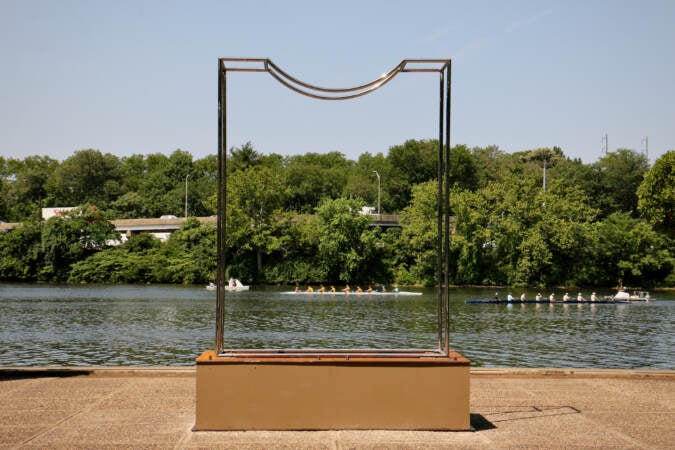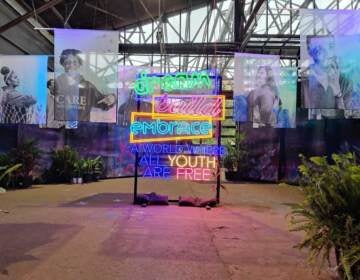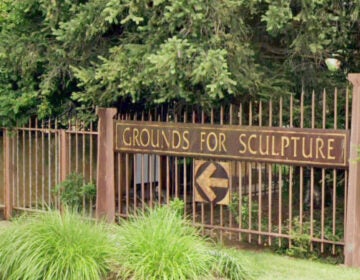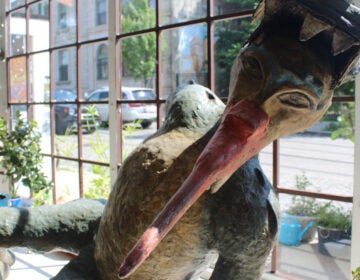Contemporary art ‘reanimates’ historic sculpture garden on the Schuylkill River
Maren Hassinger’s “Steel Bodies” reanimates a vision of American history at the Ellen Phillips Samuel Memorial along the Schuylkill River.
Listen 1:27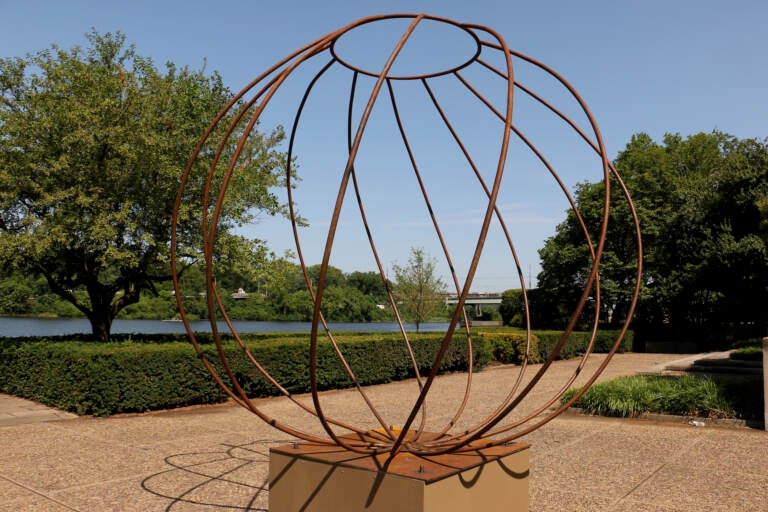
"Steel Bodies," an installation of 10 large-scale open metal vessel sculptures by Maren Hassinger, are on display at the Ellen Phillips Samuel Memorial sculpture garden through November 12. (Emma Lee/WHYY)
For the first time since it was completed more than 60 years ago, the historic sculpture garden along the Schuylkill River Trail in Philadelphia is getting a fresh perspective.
The 17 allegorical figures representing American ideals and the development of the United States as a nation are now joined by 10 abstract steel sculptures by the New York-based artist Maren Hassinger.
“Steel Bodies” are made of bent and welded rods forming the outlines of large vessels, like baskets, vases, and jars. No two are alike.
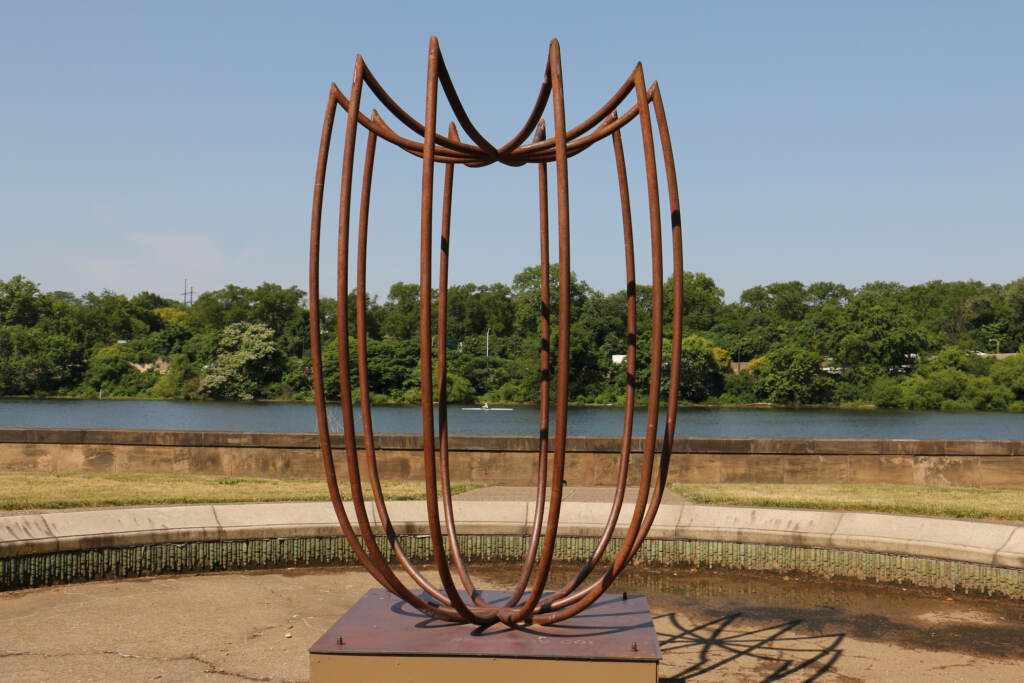
Hassinger originally designed the set of pieces for the Socrates Sculpture Park in New York City, where they were on display until last March. The Association for Public Art then brought the pieces to Philadelphia to act as a counterpoint to the figures in the memorial sculpture garden.
“Historically, the vessel form has stood in for the human form in art,” said project manager Susan Myers. “She’s using the vessel form as a way of symbolizing humans.”
The first time Hassinger came to Philadelphia to see her pieces installed, it was at 5 p.m. on a Wednesday. She was struck by how the noise from rush hour traffic along Kelly Drive just a few feet away interfered with the meditative serenity she intended with “Steel Bodies.”
“Even though I consider these to be vessels which are somehow reminiscent of the idea of a human body — it contains our soul and our heart and all the things that keep us being human,” she said. “But I actually just wanted them to be calm, quiet, almost solemn singular objects in a space that was primarily natural.”
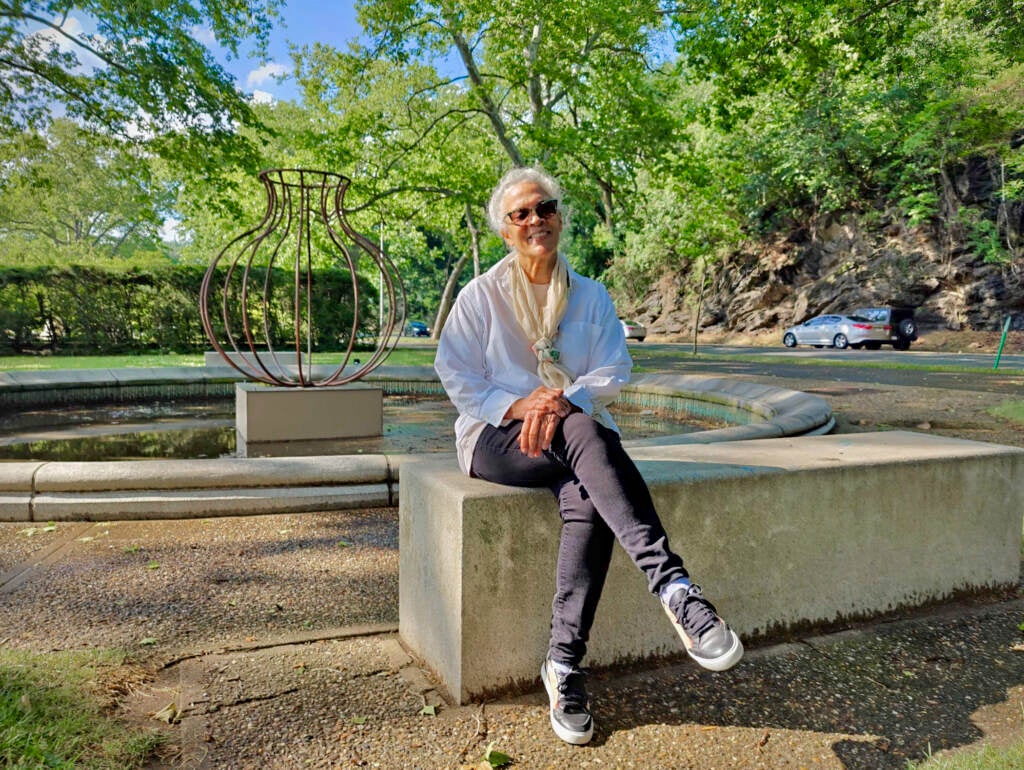
“It’s a place to focus, a sort of meditation, in spite of the fact that the traffic is roaring by and there’s lots and lots of noise from it,” Hassinger added.
The sculpture garden depicting the history of America has its own complicated history.
The concept started 110 years ago when a prominent Philadelphia philanthropist, Ellen Phillips Samuel, left a significant portion of her estate to the Association for Public Art (then called the Fairmount Park Art Association) toward the creation of a patriotic American sculpture garden.
At the time the site was much more serene. What is now Kelly Drive was a little-used gravel road.
Samuel wanted the sculpture garden to be a row of portrait statues representing significant individuals in the history of the United States. She died in 1913, her husband died in 1927, and by the time her estate was settled in 1929 the Fairmount Park Art Association abandoned Samuel’s original idea, instead leaning into a more contemporary notion of commissioning statuary that represented concepts, not identifiable persons.
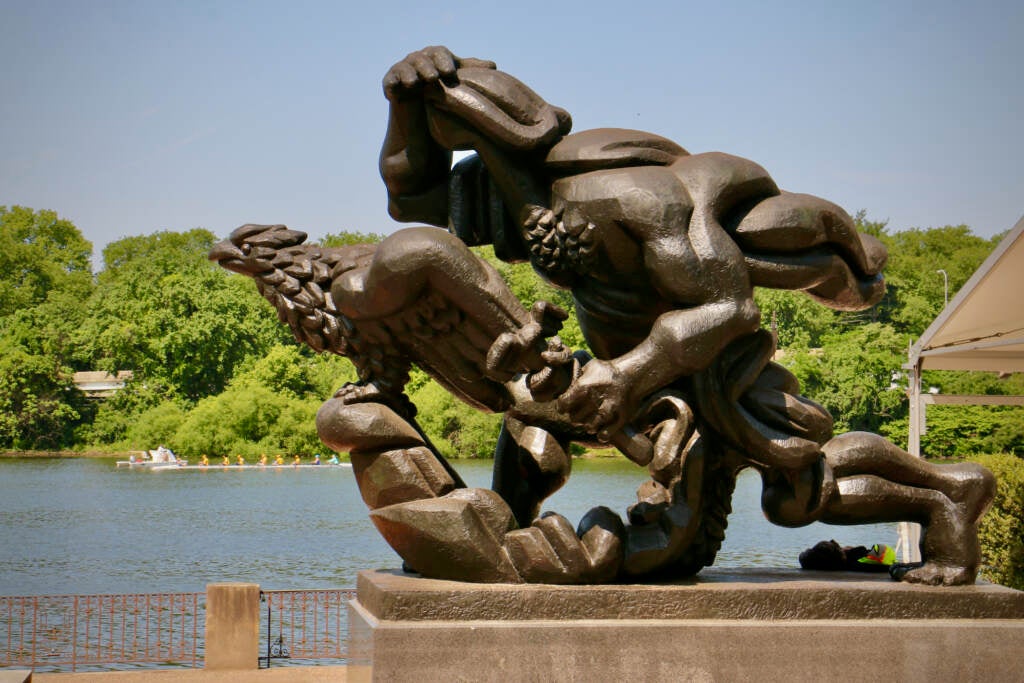
After staging three international sculpture expositions in Philadelphia in the 1930s and ‘40s, the Art Association commissioned 16 artists to make work on the themes of settling the land and developing industry, expanding westward, and the spiritual values that shaped America.
The statues include figures like The Ploughman (“They Broke the Land for Harvest”), The Miner (“They Searched the Earth for Treasure”), The Scientist (“He Weighed the Stars”), The Preacher (“He Guided Our Ways”), The Statesman, The Soldier, The Poet, etc.
“Virtually anyone who has contemplated the Samuel Memorial, even in passing, can sense there is something unsettling about the choice of sculpture,” wrote the former director of the Association for Public Art, Penny Balkin-Bach, in her book “Public Art in Philadelphia.”
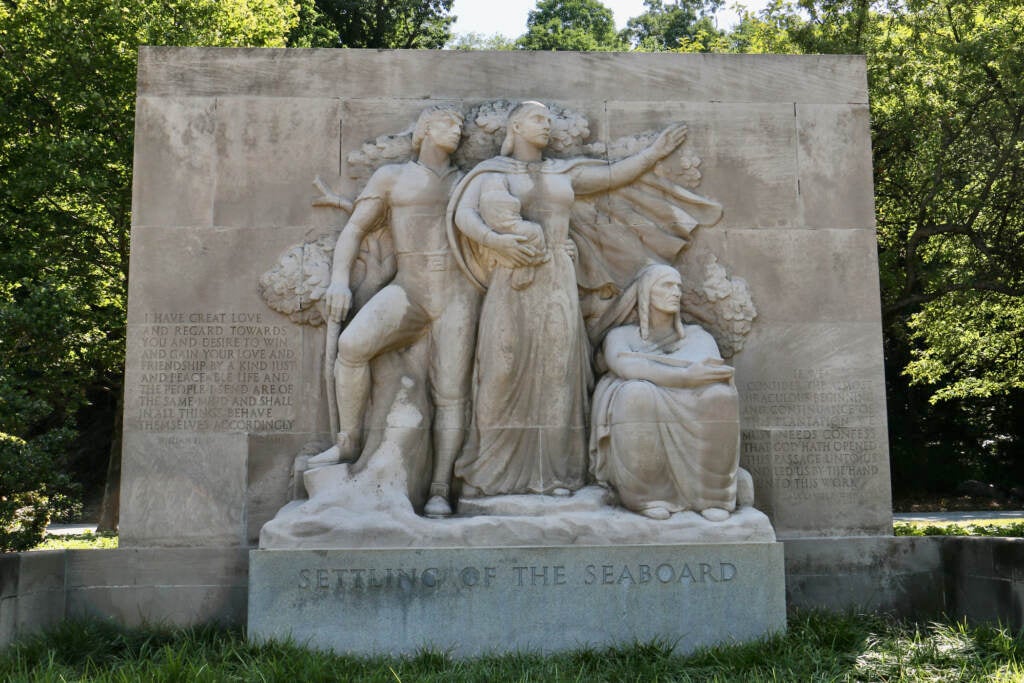
“From 1933 to 1949, American culture was being transformed by the depression and a world war,” she wrote. “The Samuel Memorial is emblematic of that period of turmoil and transition when artists and patrons were in search of new forms and meaning in an increasingly volatile world.”
Even the Association for Public Art’s own website admits the sculpture garden is problematic, reflecting “a narrow view of the history of America as it lacks an authentic Indigenous perspective; presents an enslaved Black person in shackles, and highlights primarily white European immigrants.”
There is one sculpture with obvious African features: a crouched, shackled figure representing The Slave. It appears opposite another crouched and huddled figure, The Immigrant, in a section of the garden about the pursuit of freedom. The two figures act as sentries, opening toward a central pair of allegorical figures with arms raised and shackles broken.
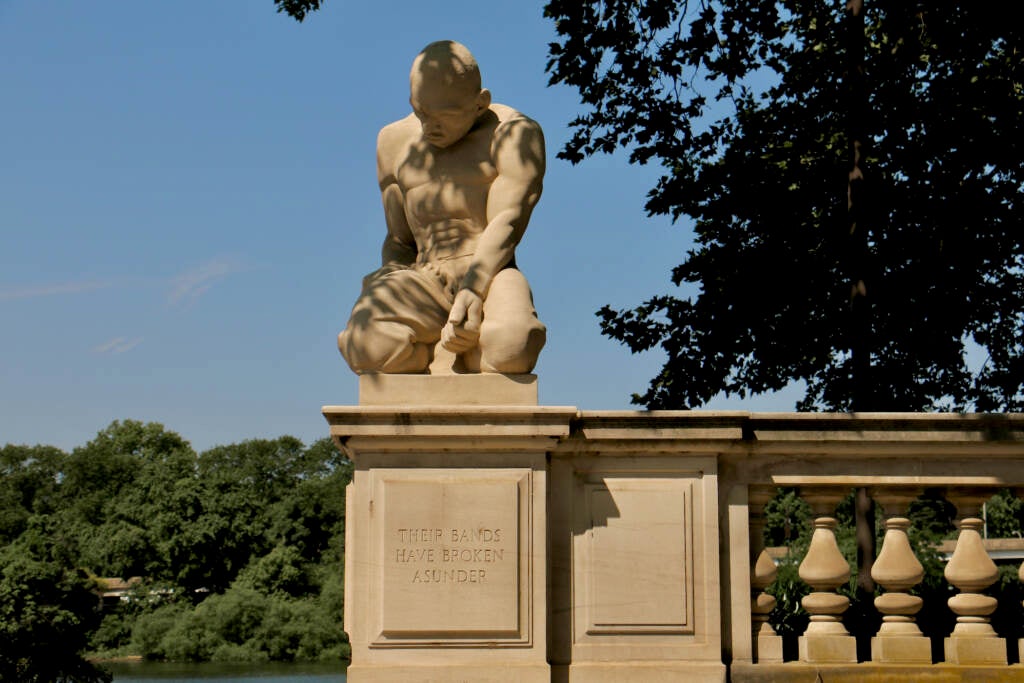
A crouched Native American figure appears in a large relief sculpture “Settling the Seaboard,” accompanied by a quote from William Penn, who created a land treaty with the Lenni Lenape people. The figure suggests a false complicity from Indigenous people regarding the westward expansion of the new American nation, proudly represented in a nearby terrace.
“As any kind of memorial that’s talking about the emblematic history of America, it’s complicated,” said Myers. “It’s from one perspective usually. That can lead to some representation issues.”
Myers said the Association does not have the resources to revamp or update the sculpture garden, however it can “enliven” the space by installing new, contemporary work in the space that might shake up the six decade-old vision of American history.
The temporary installation of “Steel Bodies” is intended to be the first of an ongoing series of contemporary interventions at the site.
“We want to revitalize. We want to reimagine, reanimate the space with a contemporary perspective,” she said. “To bring attention to this historic landmark.”

Hassinger, who did not originally conceive “Steel Bodies” for this site, does not see her steel vessel skeletons commenting on the vision of American history surrounding them.
When she visited the site after her pieces were installed, she only saw the mature sycamore trees surrounding them, the flow of the Schuylkill River, and the sky opening above the canopy.
“Let’s pay attention to the ground and the trees and the sky and the water,” she said. “I made them as witnesses to nature.”
“Steel Bodies” will be on view until November 12.

Get daily updates from WHYY News!
WHYY is your source for fact-based, in-depth journalism and information. As a nonprofit organization, we rely on financial support from readers like you. Please give today.






